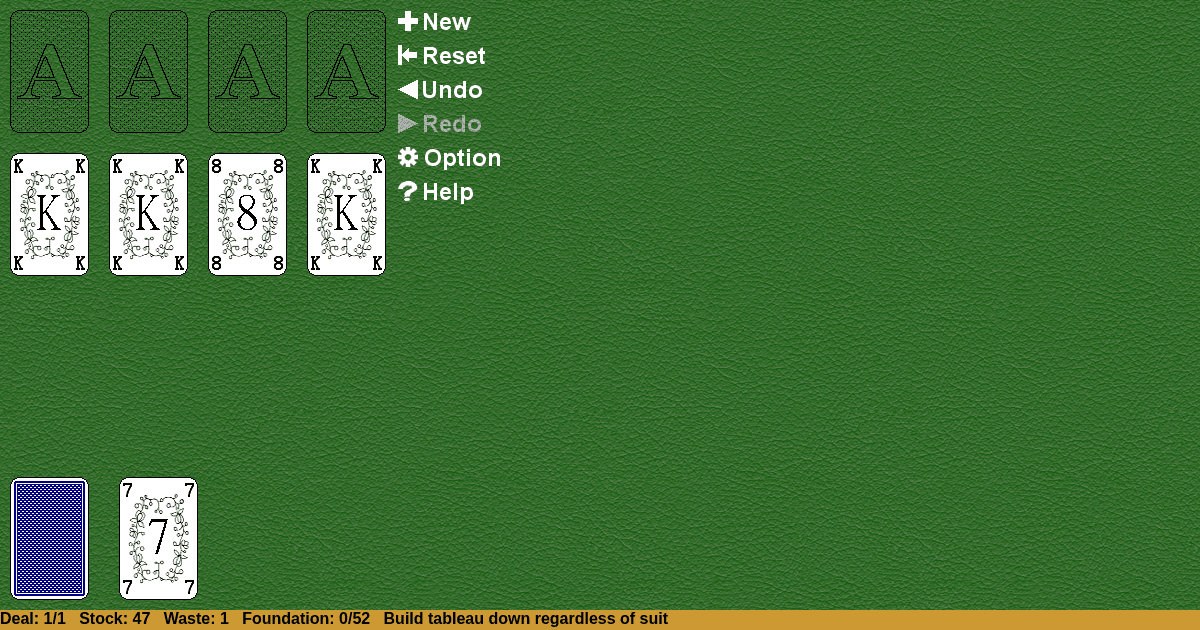Assembly
Home |
How to play |
FAQ |
About
How to play Assembly?
Game Objective:
The primary goal in Assembly Solitaire is to move all cards from the deck into the foundation piles, organizing each pile by suit in ascending order from Ace to King.
Setup & Layout:
- Deck Used: Standard 52-card deck.
- Tableau: Seven columns (piles) are created from left to right.
- The first column has one card (face up).
- The second column has two cards (top card face up, rest face down).
- The third column has three cards (top card face up, rest face down).
- Continue this pattern up to the seventh column, which has seven cards (top card face up, rest face down).
- Stock Pile: The remaining cards after the tableau setup are placed face down as the stock pile.
- Waste Pile: Cards drawn from the stock that cannot be played immediately are placed face up in the waste pile.
- Foundations: Four empty spaces designated for building up each suit from Ace to King.
Assembly Solitaire Rules:
- Card Movement: Cards may be moved among tableau columns, from the stock or waste pile, and to the foundation piles.
- Building Sequences in Tableau:
- Cards in tableau columns must be placed in descending order and alternating colors (red on black, black on red).
- Example: Place a 7 of clubs (black) on an 8 of hearts (red).
- Runs (sequences of cards) maintaining correct order and color alternation may be moved together.
- Foundation Building:
- Each foundation pile accepts only one suit.
- Cards must be placed in ascending order, starting with Ace and ending with King.
- Moving Cards:
- Only the top face-up card of each tableau pile is available for play.
- When a face-up card is moved, flip the next face-down card in that pile face up.
- Cards from the waste or stock pile can be played to tableau or foundation if they follow the respective rules.
- Only a King (or a sequence starting with a King) may be placed in an empty tableau column.
Gameplay:
- Turn Sequence:
- Move available face-up cards within the tableau or to the foundations.
- Flip the next face-down card in a tableau pile when the top face-up card is moved.
- Draw cards from the stock pile (usually three at a time, but some variants allow one at a time).
- Play the top card from the waste pile to tableau or foundations if possible.
- If no moves are possible, draw again from the stock pile.
- When the stock pile is exhausted, turn over the waste pile (without shuffling) to form a new stock pile.
- No Legal Moves:
- If no moves are possible and the stock pile cannot be recycled, the game ends.
Winning & Losing Conditions:
- Winning: The game is won when all cards are correctly placed in the foundation piles, each from Ace to King in suit order.
- Losing/Unwinnable State: The game is lost if no further legal moves can be made and the stock pile cannot be recycled.
Special Rules & Edge Cases:
- Filling Empty Tableau Columns: Only a King or a sequence starting with a King may be placed in an empty tableau column.
- Moving Cards from Foundation: Some variants allow cards to be moved back from the foundation to the tableau if it maintains the sequence and suit rules.
- Stock/Waste Cycling: When the stock pile runs out, flip the waste pile over to form a new stock; do not shuffle.
- Multiple Moves: Runs of cards in correct sequence and color alternation may be moved together between tableau columns.
- No More Moves: If all possible moves are exhausted and the stock cannot be recycled, the game ends in a loss.
Note: If "Assembly Solitaire" refers to a specific variant with unique rules differing from classic Solitaire (Klondike), official documentation is not available in the search results. The rules above reflect the standard Solitaire (Klondike) ruleset as described in official sources. If you require guidance for a different variant, please provide its official rulebook or a more detailed description.

Solitaire Collection
About Assembly
Rate (Assembly)
4.7 / 5
1,916 votes



























































